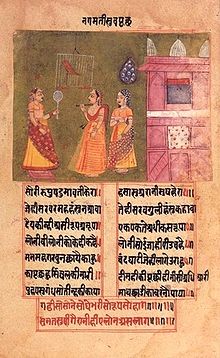This article needs additional citations for verification. (October 2021) |
 "Queen Nagmati rashly asks her new parrot who is more beautiful, she or his former owner Princess Padmavati of Sri Lanka. Naturally, she gets a displeasing answer." An illustrated manuscript of Padmavat, c. 1750 | |
| Author | Malik Muhammad Jayasi |
|---|---|
| Language | Persian and Awadhi |
| Genre | Historical Fiction Epic poetry |
| Set in | 13th–14th century India |
| Published | 1540 |
| Publication place | India |
| Text | Padmavat at Wikisource |
Padmavat (or Padmawat) is an epic poem written in 1540 by Sufi poet Malik Muhammad Jayasi,[1] who wrote it in the Hindustani language of Awadhi,[2][3] and originally in the Persian Nastaʿlīq script.[4] It is the oldest extant text among the important works in Awadhi.[5] A famous piece of Sufi literature from the period, it relates an allegorical fictional story about the Delhi Sultan Alauddin Khalji's desire for the titular Padmavati, the Queen of Chittor.[6] Alauddin Khalji and Padmavati's husband Ratan Sen are historical figures, whereas Padmavati may have been a fictional character.[7]
- ^ "Absurdity of epic proportions: Are people aware of the content in Jayasi's Padmavat?". 24 November 2017.
- ^ Padmavati isn’t history, so what’s all the fuss about?
- ^ Cite error: The named reference
businesswas invoked but never defined (see the help page). - ^ Ramya Sreenivasan 2007, p. 30.
- ^ Meyer, William Stevenson; Burn, Richard; Cotton, James Sutherland; Risley, Herbert Hope (1909). "Vernacular Literature". The Imperial Gazetteer of India. Vol. 2. Oxford University Press. pp. 430–431. Retrieved 6 April 2009.
- ^ "'Padmavat' reminds us that a major casualty of the gory Rajput conflicts were Rajput women". 25 November 2017.
- ^ Asher, Catherine B.; Talbot, Cynthia (2006). India Before Europe. Cambridge University Press. p. 106. ISBN 9780521809047.